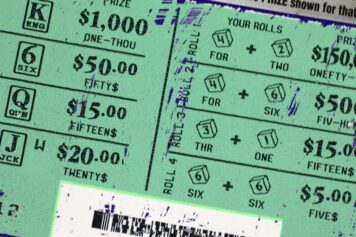
The first scratch-offs offered by the California State Lottery. The current state lottery started in 1984 after being banned for more than fifty years. (Courtesy: Wikimedia)
For millions, the allure is undeniable. The thought that one dollar and a dream could possibly change your life has drawn many to play the state lotteries. In 2015, Americans spent more on the lottery than they did on books, sports tickets, movie tickets, music, and video games combined.
Bolstered on the promise that the revenue gathered will be used for the public good, the state lotteries have grown to be a $70 billion a year business. With some states, such as Rhode Island, averaging nearly $800 a year per person in lottery spending, lotteries have grown to be a key income generator for the states, with personal income tax only beating out lottery revenues as the top government income stream in eleven states, as of 2009.
Increasingly, states are relying on the state lotteries to meet their education funding deficits, finance special projects, and satisfy budget deficits. In California, for example, the California Lottery reported 2016 sales reached $6.3 billion, with $1.5 billion going to the state’s schools. The state uses lottery revenue for school supplies purchases. The state has reported increasing lottery sales since 2010.
Proponents of the state lotteries argue that participation is voluntary, they take the emphasis off raising taxes, and they offer “harmless fun.” Critics, however, argue that the lottery is state-backed gambling. Worse, it constitutes a type of regressive tax, exploiting those least capable of paying while offering little or nothing back in recompense.
Per a 2010 study, individuals in the lowest 40 percent of the population by income are most likely to play the lottery and tend to play the lottery more times in a calendar year. According to the study, for those in the lowest 20 percent by income, the lottery is the single largest government payment they make in a year, edging out sales tax by more than $250.
If one was to argue that the retained “public good” portion of lottery revenue, which does not go toward paying prizes or administrative costs, is a tax, it is being assessed at a rate in excess of any other goods or services, short of tobacco. “Revenues raised by lotteries can be viewed as an excise tax on one item — lottery play. Georgia retains 35 cents for every dollar spent on the lottery. These lottery proceeds retained by the state represent an implicit tax on purchases of lottery products,” Ross Rubenstein and Benjamin Scafidi of Georgia State University wrote in the National Tax Journal regarding the Georgia State Lottery.
“If a competitive market existed for lottery products, it is unlikely that each firm’s profits would approach 35 percent of revenues. Although purchases of lottery tickets are ‘voluntary,’ the implicit tax on a dollar spent on a lottery product is not voluntary, just as sales taxes paid on purchased goods are not voluntary. Although the implicit taxes paid on lottery products are less than the full price of the lottery product, the implicit lottery tax rates are much higher than sales tax rates on most other items.”
It has been alleged that the poor — specifically, African-American poor — disproportionately are burdened the most by this tax while simultaneously — due to imbalanced public school funding arrangements — benefiting the least from it in regards to school and “public good” aid. The question is, is this true? Is the lottery truly slanted against those that play it? If this is the case, who truly benefits from the lottery and is there a better way to fund our schools?
The Curious Case of African-Americans and the Lottery
The modern lottery is a relatively new invention. Lotteries in the United States existed since the Colonial era; one of the first lotteries was established by the Virginia Company of London to help pay for the settlement in Jamestown, Virginia, in 1612. A key component of infrastructure and major project funding, these lotteries helped pay for roads, churches, schools, and militias in the early years of the nation.
By 1860, however, the general untrustworthiness of the various state lotteries led to all states but Delaware, Kentucky, and Missouri to ban state-run gambling. In 1934 Puerto Rico became the first American locale to develop what could be considered a modern U.S. lottery in which there are built-in auditing mechanisms to maintain the public trust and a stated purpose for the collected revenue. New Hampshire followed in 1964.
The advent of multiistate games and scratch-offs, as well as a need to raise funds without raising taxes, led to 44 states plus the District of Columbia, Puerto Rico, and the U.S. Virgin Islands to offer a lottery. Only Puerto Rico of the 47 lottery-enabled territories and states currently do not offer both the multi-state lotteries of Powerball and Mega Millions.
A look at who actually plays the lottery shows some interesting patterns that go against popular thinking. According to the research paper “Gambling on the Lottery: Sociodemographic Correlates Across the Lifespan,” written by Grace M. Barnes, John W. Welte, Marie-Cecile O. Tidwell, and Joseph H. Hoffman, the study found that non-Hispanic whites and Native Americans are most likely to play the lottery. Moreover, African-Americans, per the study, have a lower propensity for buying lottery tickets than whites do.
African-Americans pay the most, per capita, for the lottery, per another study.
However, the study also suggests that African-American tend to play for longer stretches of times than whites do. Additionally, without considering race or ethnicity, those that are in the lowest fifth of the population by socioeconomic status had the “highest rate of lottery gambling (61%) and the highest mean level of days gambled in the past year (26.1 days).”These facts are problematic when one also considers that most lottery tickets are sold in poor and minority neighborhoods.
“Public Good” and Math Tricks
The acceptability of this aggressive gambling scheme is dependent on the general perception that the state-run lottery is serving the “public good,” such as funding education. The truth is that only 26 states specifically dedicate education as the purpose of lottery revenues. Per the American Association of State Colleges and Universities, 12 states allocate the funds to serve the state’s general fund or to pay for programs that would be serviced by the general fund, such as environmental conservation in the case of Minnesota. Six states have purposes that differ from the general fund or education, such as Massachusetts, whose lottery provides funding to the individual towns and cities.
How the states go about educational lottery funding vastly differs as well. Only eleven states specifically allocate lottery revenues for K-12 education, with three exclusively channeling revenues into college scholarships. Eight states do both. Eight states — Arkansas, Florida, Georgia, Kentucky, New Mexico, South Carolina, Tennessee, and West Virginia — have earmarked the lottery to pay for merit-based scholarships.
These merit-based, or need-blind, scholarships, such as Georgia’s HOPE Scholarship and Tennessee’s GAMS and ASPIRE scholarships, target high achievers without necessarily factoring in if the award is actually needed as part of a financial aid package. Due to the variability of lottery revenues, per the AASCU, the stringent nature of these scholarships may be artificially tightened to the point that only the most prepared students — usually coming from wealthy or affluent families — can ultimately get them.
“While the majority of state-based student financial aid is in the form of need-based grants, long-term trends show greater increases in non-need-based aid, according to the National Association of State Student Grant & Aid Programs’ (NASSGAP) 43rd Annual Survey, which used data from the 2011–2012 academic year. Need-based grant aid increased from $3.86 billion in 2001–2002 to $6.95 billion in 2011–2012, a 79.9 percent increase. Non-need-based aid, on the other hand, increased from $1.27 billion to $2.4 billion, a 91.9 percent increase, over the same time frame,” AASCU’s policy brief reads. “Further, eight states — California, New York, Texas, Pennsylvania, Illinois, New Jersey, Washington and North Carolina — collectively awarded 70 percent of all need-based grant aid awarded by states (2013). It is notable that none of these states have a lottery-funded scholarship program.”
The effect lottery revenues can have on education can be chilling and manifold. Many states tend to supplant educational funding with lottery revenue instead of supplementing it. What that means is that many states use lottery revenues to pay for their educational obligations under law or state budgeting priorities, while using tax revenue that would otherwise be used for education for a different purpose. Additionally, these states would use the lottery as an excuse for not increasing state education budgets. Finally, states that use lottery revenues for merit scholarship purposes overwhelmingly offer scholarships for academic merit over financial need, by a ratio of $1.6 billion in grants to $301 million.
All of this punishes students with poor college preparedness. This inequity effectively shuts out students in poorer school districts and students who cannot afford supplemental educational opportunities and tutoring. This leads to an additional burden on the lower-income populations, who already support and are targeted by the lottery in larger numbers than other income brackets.
Not all states use lottery funding in this manner. California uses lottery funds to pay for K-12 school supplies, while New York uses lottery funds for need-based scholarships and for K-12 school grants. However, in both cases, the amount of money the lottery contributes, compared to the state’s education budget, is a far smaller fraction than it is for many smaller states that use lottery revenue to fund education.
Sanctioned Gambling
This raises the question of why this is allowed to happen. The truth is that the lottery offers states an opportunity to impose a tax on the poor while being able to hide behind the idea that it is voluntary, despite the advertising and targeting the states apply to the poor to play.
“Lotteries are regressive,” Thomas L. Harnisch, director of state relations and policy analysis for the American Association of State Colleges and Universities, told Atlanta Black Star. “Many lotteries go to merit-based financial aid, which disproportionately benefits wealthy students. It’s ‘Robin Hood’ in reverse.”
“State financial aid is essential to college affordability. However, we must be cognizant of the source of this aid. There are better ways to fund state financial aid than a lottery.”
Of every lottery dollar that is spent, up to 40 percent of it and up to 45 percent of any prize won from it goes back to the government. In a practical sense, it would be more efficient and less morally complicated to simply impose a direct tax to pay for the services the lotteries are earmarked to pay for. However, the lottery serves to give those that have been systematically shut out of the massive increase of wealth post-Great Recession the opportunity to hope — if only for a while — for their share of this otherwise unreachable fortune.
The bigger question may be should states be allowed to tax a person’s hope.

